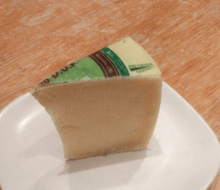Pecorino sardo facts for kids
Quick facts for kids Pecorino sardo |
|
|---|---|
 |
|
| Other names | Fiore sardo |
| Country of origin | Italy |
| Region | Sardinia |
| Source of milk | Sheep |
| Texture | Hard |
| Certification | DO, 1991; PDO, 1996 |
Pecorino sardo is a firm cheese from the Italian island of Sardinia. It is made from the milk of local Sardinian sheep. This cheese received a special status called "Denominazione d'Origine" (DO) in 1991. Later, in 1996, it was given "Protected Designation of Origin" (PDO) protection. This means only cheese made in a certain way in Sardinia can be called Pecorino Sardo.
Contents
How Pecorino Sardo is Made
Pecorino Sardo is a hard cheese that is not cooked. It starts with fresh, whole sheep's milk. To make it solid, a special ingredient called rennet (from lamb or kid) is added.
The cheese mixture is then poured into special shapes called moulds. These moulds give the cheese its round form. After a short time in salty water (called brine), the cheeses are lightly smoked.
Finally, the cheeses are left to ripen in cool cellars in central Sardinia. This ripening process helps the cheese develop its flavor.
What Pecorino Sardo Looks Like
A finished Pecorino Sardo cheese usually weighs about 3.5 kilograms (about 7.7 pounds). The outside rind can be deep yellow to dark brown. Inside, the cheese itself is white to straw-yellow.
The taste of the cheese depends on how long it has ripened. Young Pecorino Sardo is usually only a couple of months old. It has a milder flavor.
The mature type is more than six months old. This older cheese needs careful control of temperature and humidity as it ages. It has a much sharper and stronger flavor.
Pecorino Sardo Around the World
Outside of Italy, Pecorino Sardo is not as famous as some other Italian sheep's milk cheeses, like Pecorino Romano. However, a lot of Pecorino Romano is actually made in Sardinia. This is because Sardinia is part of the area where Pecorino Romano can be produced under its own PDO rules.
In the United States, you will most often find Pecorino Sardo in its hard, more mature form.
See also
 In Spanish: Pecorino sardo para niños
In Spanish: Pecorino sardo para niños

